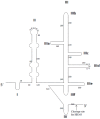Aptamer-based therapeutics: new approaches to combat human viral diseases
- PMID: 24287493
- PMCID: PMC3873675
- DOI: 10.3390/ph6121507
Aptamer-based therapeutics: new approaches to combat human viral diseases
Abstract
Viruses replicate inside the cells of an organism and continuously evolve to contend with an ever-changing environment. Many life-threatening diseases, such as AIDS, SARS, hepatitis and some cancers, are caused by viruses. Because viruses have small genome sizes and high mutability, there is currently a lack of and an urgent need for effective treatment for many viral pathogens. One approach that has recently received much attention is aptamer-based therapeutics. Aptamer technology has high target specificity and versatility, i.e., any viral proteins could potentially be targeted. Consequently, new aptamer-based therapeutics have the potential to lead a revolution in the development of anti-infective drugs. Additionally, aptamers can potentially bind any targets and any pathogen that is theoretically amenable to rapid targeting, making aptamers invaluable tools for treating a wide range of diseases. This review will provide a broad, comprehensive overview of viral therapies that use aptamers. The aptamer selection process will be described, followed by an explanation of the potential for treating virus infection by aptamers. Recent progress and prospective use of aptamers against a large variety of human viruses, such as HIV-1, HCV, HBV, SCoV, Rabies virus, HPV, HSV and influenza virus, with particular focus on clinical development of aptamers will also be described. Finally, we will discuss the challenges of advancing antiviral aptamer therapeutics and prospects for future success.
Figures



Similar articles
-
Use of Aptamers as Diagnostics Tools and Antiviral Agents for Human Viruses.Pharmaceuticals (Basel). 2016 Dec 16;9(4):78. doi: 10.3390/ph9040078. Pharmaceuticals (Basel). 2016. PMID: 27999271 Free PMC article. Review.
-
Aptamer-based diagnostic and therapeutic approaches for animal viruses: A review.Int J Biol Macromol. 2024 Feb;257(Pt 2):128677. doi: 10.1016/j.ijbiomac.2023.128677. Epub 2023 Dec 10. Int J Biol Macromol. 2024. PMID: 38072350 Review.
-
Aptamers for Anti-Viral Therapeutics and Diagnostics.Int J Mol Sci. 2021 Apr 17;22(8):4168. doi: 10.3390/ijms22084168. Int J Mol Sci. 2021. PMID: 33920628 Free PMC article. Review.
-
Application of Aptamers in Virus Detection and Antiviral Therapy.Front Microbiol. 2019 Jul 3;10:1462. doi: 10.3389/fmicb.2019.01462. eCollection 2019. Front Microbiol. 2019. PMID: 31333603 Free PMC article. Review.
-
Development of cell-type specific anti-HIV gp120 aptamers for siRNA delivery.J Vis Exp. 2011 Jun 23;(52):2954. doi: 10.3791/2954. J Vis Exp. 2011. PMID: 21730942 Free PMC article.
Cited by
-
Oligonucleotide aptamers: potential novel molecules against viral hepatitis.Res Pharm Sci. 2017 Apr;12(2):88-98. doi: 10.4103/1735-5362.202447. Res Pharm Sci. 2017. PMID: 28515761 Free PMC article. Review.
-
Aptamer-decorated nanocarriers for viral adsorption: A special look at COVID-19.Mol Ther Nucleic Acids. 2024 Aug 15;35(3):102310. doi: 10.1016/j.omtn.2024.102310. eCollection 2024 Sep 10. Mol Ther Nucleic Acids. 2024. PMID: 39281706 Free PMC article. Review.
-
EpCAM Aptamer-mediated Survivin Silencing Sensitized Cancer Stem Cells to Doxorubicin in a Breast Cancer Model.Theranostics. 2015 Oct 20;5(12):1456-72. doi: 10.7150/thno.11692. eCollection 2015. Theranostics. 2015. PMID: 26681989 Free PMC article.
-
RNA Interference Therapies for an HIV-1 Functional Cure.Viruses. 2017 Dec 27;10(1):8. doi: 10.3390/v10010008. Viruses. 2017. PMID: 29280961 Free PMC article. Review.
-
Predicting the Uncertain Future of Aptamer-Based Diagnostics and Therapeutics.Molecules. 2015 Apr 16;20(4):6866-87. doi: 10.3390/molecules20046866. Molecules. 2015. PMID: 25913927 Free PMC article. Review.
References
Grants and funding
LinkOut - more resources
Full Text Sources
Other Literature Sources
Miscellaneous

